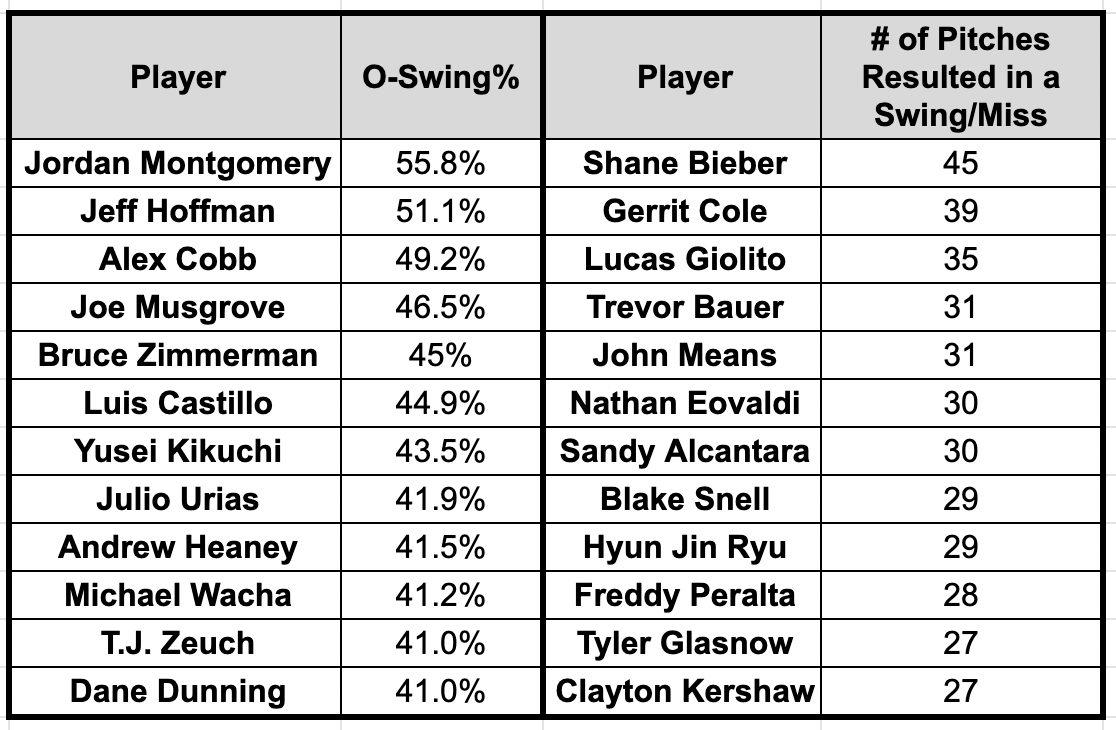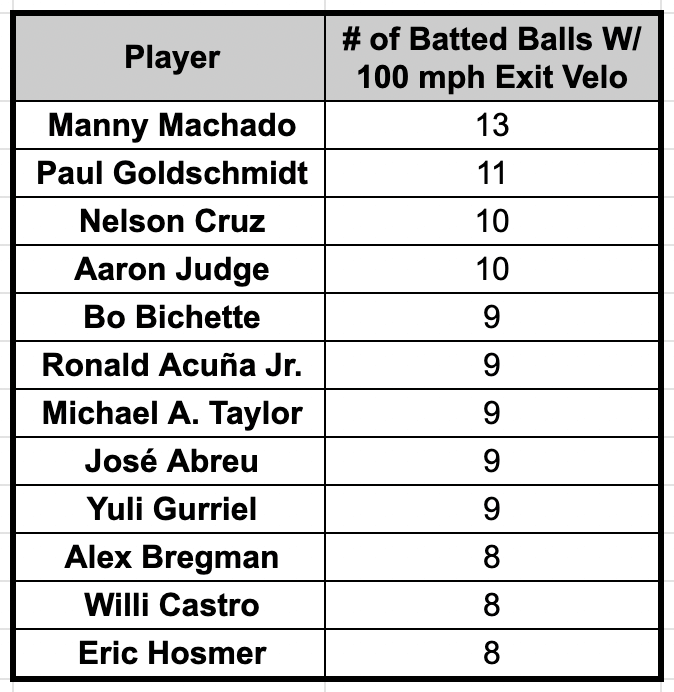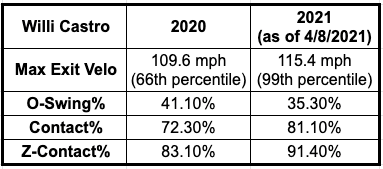With just over a week into the fantasy baseball season, let’s take a brief look at leaders in a few stats and what to watch for with a few notable players. Keep in mind that many baseball statistics take more time to stabilize before some become more legitimate than others. For this piece, we’ll look at the pitching leaders in chase rate (O-Swing%) and swings and misses. For hitters, we’ll find guys with an exit velocity above 100 mph, which isn’t a large group, but we find some intriguing names. Our O-Swing% comes courtesy of FanGraphs and the rest via Baseball Savant. That said, let’s look at the two of the sexier outcomes for baseball.
Pitcher Leaders in O-Swing% & Swings/Misses
When looking at chase rate, we’re using the FanGraphs leaderboard for O-Swing%. Below shows the leaders in O-Swing% amongst starting pitchers. We also have a column for the number of pitches that resulted in a swing and miss. Granted this list is more about volume, but still brings light to notable names in John Means and Freddy Peralta.
We notice some intriguing names and sleepers in Jordan Montgomery and Yusei Kikuchi with a mix of legitimate starters in Gerrit Cole and Clayton Kershaw. On the flip side, lesser-known guys in Jeff Hoffman and Bruce Zimmerman end up here as well. Jordan Montgomery landed on my Ten Must-Have Starting Pitchers and I loved his first start of 2021. Let’s touch on Hoffman and Zimmerman to figure out what’s going on there.
Jeff Hoffman spent his entire career with the Rockies before landing with the Reds. Throughout his career with the Rockies, Hoffman had a 6.40 ERA, 1.62 WHIP, 18.8% strikeout rate, and 10.2% walk rate in 230.2 innings pitched. That’s not great, but we’ll give Hoffman a pass since it’s difficult to rely on the Rockies player development and it’s not a pitcher-friendly ballpark.
On the other hand, the Reds have Kyle Boddy as their Director of Pitching. Boddy is the founder of Driveline Baseball, an organization that’s known for data-focused player development. The nickname for the Reds is Spincinnati since they helped some of their pitchers add revolutions on their pitches. It’s one start for Hoffman but put him on your watch list as a speculative pickup, particularly due to his new and improved slider.
For Bruce Zimmerman, don’t jump on him quite yet. The only Orioles starter worth rostering at this point involves John Means. Speaking of Orioles pitchers or former ones, we have Alex Cobb who ranked highly in O-Swing% with his one start. Cobb recorded a quality start with seven strikeouts, one walk, and three earned runs across six innings pitched. Now that Cobb pitches for the Angels, he’s a bit more intriguing with that filthy splitter eliciting a 34.3% swinging-strike in his only 2021 start and a 21.8% swinging-strike rate in 2020.
Another pitcher to note – Yusei Kikuchi after his dominant ten strikeout outing against the Giants. Kikuchi allowed six hits, three earned runs, and one walk with ten strikeouts in six innings pitched. He primarily used his cutter similar to 2020, but lowered the four-seam usage and increased the slider usage. However, it’s only one start, but a good start overall by limiting the walks. It’s difficult to wait and see with any player, so scoop up Kikuchi if he isn’t rostered.
Many people, including myself, love Freddy Peralta, and rightfully so, as he consistently improved throughout his career. Primarily in a relief role in 2019 and 2020, Peralta held a 4.96 ERA, 1.38 WHIP, 32% strikeout rate, and 9.7% walk rate. His bread and butter involve the fastball and slider, but the issues for Peralta revolve around command and control. In two appearances in 2021, Peralta hasn’t allowed an earned run, one of which ended as a scoreless five-inning start with four walks and eight strikeouts. This season, both his four-seamer (14.1%) and slider (25%) have solid swinging-strike rates, which he primarily uses over 92% of the time. Hopefully, you bought into the Peralta hype because 2021 feels like his breakout season.
Hitters With an Exit Velocity of At Least 100 MPH
The only hitters that stand out in the top ten are Yuli Gurriel and Michael A. Taylor with nine batted balls each with an exit velocity of at least 100 mph. Gurriel is a boring veteran that produced quite well in 2019 with 31 home runs, 85 runs, 104 RBI, and five steals with a .298 batting average. In 2020, Gurriel struggled with a .232 batting average yet provided six home runs, 27 runs, and 22 RBI. In the early goings of 2021, Gurriel is crushing the ball with a 66.7% hard-hit rate and 11.1% barrel rate. The hard-hit rate isn’t sustainable, and Gurriel typically posted barrel rates hovering around 3%, so that’s also not sustainable. It’s likely an early-season hot surge for Gurriel.
We stopped at top-12, but we have about ten hitters tied with eight batted balls of at least 100 mph. Other notables names tied for eight include Trevor Story, Carlos Correa, Jeimer Candelario, Max Muncy, and José Ramírez. Let’s touch on a few that stand out as early-season surprises in Michael A. Taylor and Willi Castro. Taylor has a six-game hit streak going with a .391 batting average, two home runs, four runs, and six RBI. He’s straight destroying baseballs evidenced by his 23.5% barrel rate and 52.9% hard-hit rate. Although it’s early, Taylor finds himself on a list of elite hitters. With his recent swing change using a toe tap instead of a leg kick, Taylor looks to continue this success with the potential for a 20 home run and 20 steal season if it all clicks.
Tigers’ shortstop Willi Castro took advantage of his opportunity in 2020 due to Niko Goodrum’s injury. Castro performed well with a .349 batting average boosted by his .448 BABIP in 140 plate appearances. However, Castro boasted a high BABIP and batting average throughout the minors, so his batting average could remain high but just not as high as 2020.
Willi Castro isn’t off to a blazing start yet he’s smashing the ball, particularly in Wednesday’s game against the Twins. He demolished four batted balls of 110.8, 103.6, 107.6, and 107.6 mph in Wednesday’s loss to the Twins. Even Castro’s maximum exit velocity up to this point ranks in the top one percent of the league at 115.4 mph. Castro exceeded his max exit velocity from 2020 by almost six mph, wow! It’s a small sample, but Castro is making more contact and lowering his chase rate. Making more hard contact plus chasing fewer hints at some solid incoming performances. Monitor these plate discipline changes under the hood.




